Understanding Truffles: Nature’s Underground Treasure
Truffles are a type of fungus that grows underground. They are not related to chocolate truffles, which are sweet confections. These fungi form a unique partnership with the roots of certain trees, like oak, hazelnut, and beech. Truffles get nutrients from the tree and, in return, help the tree absorb water and minerals.
Truffles are prized for their intense aroma and flavor. They have a strong, earthy scent that chefs love. This makes them a luxury ingredient in cooking. People use truffles to enhance dishes like pasta, risotto, eggs, and meats.
Finding truffles is a special skill. They grow hidden beneath the soil, making them hard to locate. Traditionally, trained dogs or pigs sniff out truffles by detecting their scent. Harvesting truffles requires care to avoid damaging them or the surrounding environment.
There are many varieties of truffles worldwide. The most famous are black and white truffles from Europe. Each variety has its own distinct aroma and taste. Some are better served raw, while others improve with cooking.
Truffles are rare and seasonal. Their scarcity adds to their high cost. Despite this, their unique flavor makes them highly sought after by chefs and food lovers everywhere.
Earthly Truffles – The Diamonds of the Kitchen
Truffles are subterranean fungi that flourish through a symbiotic relationship with the roots of certain trees, such as beech, hazel, and oak. They are not mushrooms, which are completely different fungi. They are also not to be confused with the chocolate confection that bears the same name.
There are over 200 known species of truffles, but only a handful are commercially valuable or highly prized for their culinary qualities. These belong mostly to the genus Tuber. Here’s a breakdown of the most notable varieties:
| Truffle Name | Scientific Name | Flavor Profile | Season | Region |
|---|---|---|---|---|
| Black Winter Truffle | Tuber melanosporum | Earthy, chocolatey, intense | Winter (Dec–Mar) | France, Spain, Italy |
| Black Summer Truffle | Tuber aestivum | Mild, earthy, slightly nutty | Summer–Fall | Europe |
| White Winter Truffle | Tuber magnatum | Pungent, garlicky, musky | Fall (Oct–Dec) | Italy (Piedmont), Croatia |
| White Summer Truffle | Tuber borchii | Milder, garlicky, less pungent | Late winter–spring | Italy, Central Europe |
| Burgundy Truffle | Tuber uncinatum | Nutty, less intense than black | Fall–Winter | France, Central Europe |
| Chinese Black Truffle | Tuber indicum | Milder, less aromatic | Winter | China |
| Oregon White Truffle | Tuber oregonense, T. gibbosum | Piney, garlicky | Winter–Spring | Pacific Northwest (U.S.) |
| Oregon Black Truffle | Leucangium carthusianum | Fruity, subtle | Late fall–Winter | Pacific Northwest (U.S.) |
Summer or Winter Truffles
Summer truffles, both white and black, have a milder flavor than winter truffles. They are less pungent and more subtle. Because of this, they are generally considered less intense but still tasty.
White truffles shine when served raw. Cooking them dulls their signature aroma and flavor. Black truffles, on the other hand, actually improve when cooked—the heat helps release their rich, earthy notes.
Winter white truffles are highly prized for their strong garlic and shallot aroma. Their skin ranges from cream to yellowish, and it is smooth compared to the rough skin of black truffles.
Summer white truffles belong to the same species as winter white truffles and look very similar. The main difference is their harvest season. Summer whites have a lighter fragrance than winter whites but remain a great choice.
Winter black truffles have a dark gray to brownish-black, bumpy exterior. Inside, thin white veins run through the flesh, indicating maturity. They are famous for their intense earthy and chocolaty flavor, making them the top choice for cooking.
Summer black truffles look like winter blacks on the outside but have a slightly grayer interior. They offer a pleasant but softer pungency compared to their winter counterparts.
| Truffle Name | Appearance | Better Raw or Cooked | Cost |
|---|---|---|---|
| Black Winter Truffle | Black with rough, warty exterior and white marbling inside | Better raw (thinly shaved) | $$$ |
| Black Summer Truffle | Dark brown to black, smoother and less dense than winter truffle | Better cooked (adds subtle flavor) | $ |
| White Winter Truffle | Light tan to cream, smooth with fine veins | Better raw (thinly shaved) | $$$$ |
| White Summer Truffle | Light cream to pale brown, smoother than white winter truffle | Better cooked or raw (milder flavor) | $$ |
| Burgundy Truffle | Dark brown-black exterior with marbled interior | Raw or lightly cooked | $$ |
| Chinese Black Truffle | Black, similar to winter truffle but less dense | Cooked (less aromatic raw) | $ |
| Oregon White Truffle | Light tan, smooth exterior, white veins | Better raw or lightly cooked | $$ |
| Oregon Black Truffle | Dark purple-black with wrinkled surface | Better cooked to release aroma | $$ |
Summary:
White truffles are usually served raw to preserve aroma and are more expensive due to rarity and intense fragrance.
Black truffles work well cooked and have a stronger earthy flavor that intensifies with heat.
Summer truffles (both colors) have a subtler taste and lower cost than winter truffles.
Where To Purchase Fresh Truffles Online?
Only Buy From Reputable Purveyors
I would start there if you are near a great specialty market or have a supermarket that carries exotic gourmet items. You may or may not get lucky.
If not, there are a number of reputable sources online including Amazon.com which includes a number of purveyors who market fresh truffles as well as other truffle products.
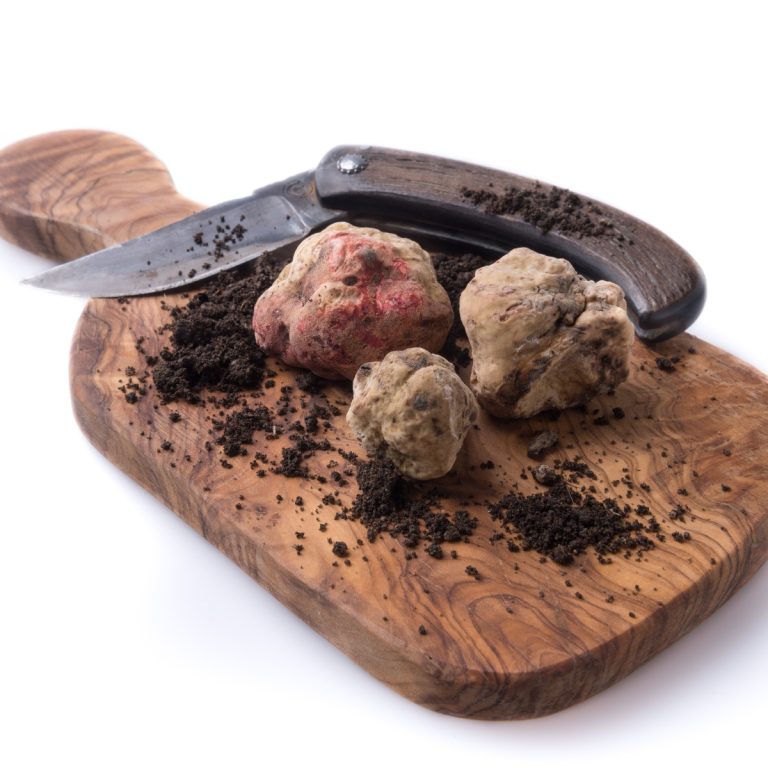
Truffle Oil
The next best thing is if you don’t have fresh truffles.
Some of you may have heard of or even used truffle oil. Many professional chefs consider truffle oil a reasonable, and more reasonably priced, substitute for truffles. Most commercially produced truffle oils are artificially flavored, however. This is not necessarily a bad thing, know that, if you are purchasing truffle oil, it most likely is not made with truffles, although its flavor might be very pungent and pleasing.
You will find many varieties of truffle-infused oil including Black Truffle Oil, White Truffle Oil, Concentrated Truffle Oil, French, and Italian from various producers. The Italian truffles are the best known, but the French Perigord Truffle also called Winter Black Truffle are exquisite.
Truffle oils are generally not used in cooking, as the heat adulterates their flavors. Instead, they are added after a dish is prepared or used in salads and other cold dishes. You can add small amounts to soups, stews or sautees to add an additional layer of flavor.
What’s In A Name
The name “truffle” comes from the Latin for “lump.” Not a very auspicious name for such an expensive ingredient, but it is descriptive.
Truffles belong to a family of fungi that grow underground in a symbiotic relationship with certain trees, most notably oak, but also hazel, beech, and poplar. Since they do grow under the soil, they are difficult to find.
Historically, pigs were used to hunt down truffles. Pigs do not need to be trained to do this; this is an innate ability.
Scientists think that it might have to do with the truffles giving off a pheromone that attracts the pigs. The downside of using pigs to find truffles is that, not only are they genetically predisposed to find truffles, but they are also predisposed to eat them once found.
As you can imagine, this trait is not good for the truffle farmer’s pocketbook. Most farmers now use dogs specially trained to sniff out truffles, much like dogs are trained to sniff out illegal drugs.
Truffle Hunting in Siena
Dogs are not as piggy as the pigs who wolf down the truffles

The Truffle Shaver
An Inexpensive Gadget For A Very Expensive Ingredient
The truffle shaver was developed to make the most of a costly ingredient. The thinner the slices, the longer the truffle will last. And, since truffles are extremely pungent and flavorful, a little goes a long way. Truffle shavers look very similar to a cheese plane. They differ in that you can control the thickness of each slice by turning a nut on the slicer. Slices can range in thickness from almost paper thin to about 1/8″.
At first glance, the truffle shaver might seem like a one-trick pony-that all it is good for is shaving truffles. While this is the reason they were developed, you can also use a truffle shaver to shave hard cheese, such as Parmesan and Romano, for thin-slicing garlic or shallots, and for shaving chocolate.
You can also use a truffle shaver to make thin slices of almost any small, hard vegetable or fruit, such as radishes, mushrooms, new potatoes, strawberries, and kiwi. You can even use it to make thin slices of ginger making kimchi!
Cultivating Truffles
It’s All About Supply & Demand
Contrary to what many people think, it is possible to cultivate truffles. This was done very successfully and on a large scale back in the late 1800s in France. Farmers would plant acorns dropped by oak trees that had truffles at their bases in other fields, and in a few years: voila-truffle fields.
As the life cycle of the symbiotic relationship between tree and fungus is only about 30 years, these fields are no longer productive. World Wars I and II also greatly interfered with truffle production. Today’s farmers are against mass cultivation, as the relative scarcity of truffles keeps the demand-not to mention the price-high.
Truffles are grown in many parts of Europe but are most notable in France and Italy. China produces a lot of truffles, but they are often considered inferior quality to European truffles. Believe it or not, there is even domestic production of the black truffle. There are truffle-producing groves in the Piedmont areas of North Carolina and Virginia!
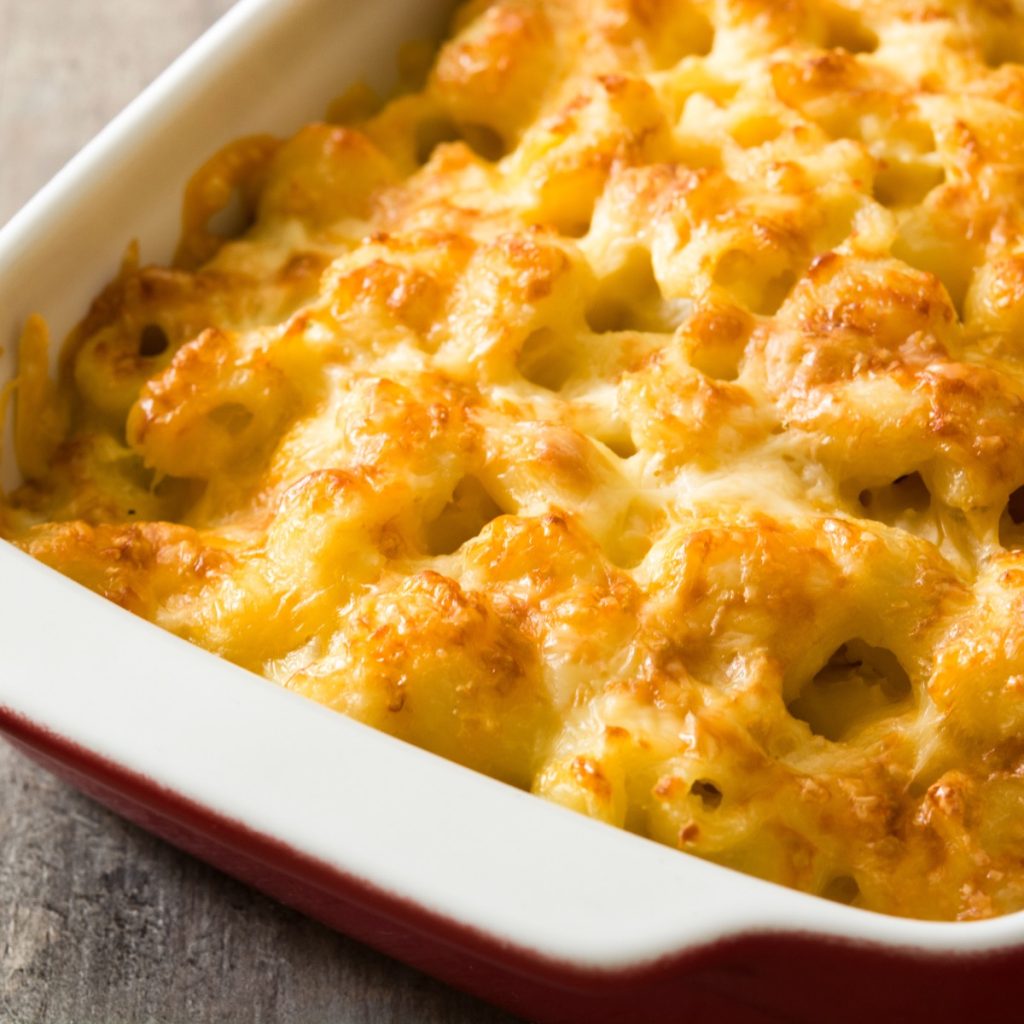
Truffled Macaroni and Cheese
I’m not sure the kids will eat this Mac & Cheese but you could try
Truffle macaroni and cheese seems to be all the rage right now, and why not? Almost everyone loves rich and creamy mac and cheese. Add to it the earthy depth that truffles can bring, and you have the perfect upscale side dish for a special meal.
Wild Mushroom Macaroni and Three Cheeses with Truffle Oil
Ingredients
- 1 cup crimini mushrooms sliced
- 1 cup shitake muchrooms sliced
- 2 tablespoons olive oil
- 1½ tablespoons dry sherry
- 3 tablespoons butter
- 3 tablespoons flour
- 3 cups whole milk warmed
- 4 ounces herbed goat cheese crumbled
- 4 ounces sharp cheddar shredded
- 3 ounces fontina cheese shredded
- 1 tablespoon fresh thyme leaves
- 2 tablespoons truffle oil or to taste
- 10 ounces elbow pasta
- salt and fresh cracked pepper to taste
- 2 ounces Parmigiano Reggiano cheese
- ½ cup panko breadcrumbs
Instructions
- Heat a skillet and then add the olive oil.
- Once the oil is hot, add the mushrooms, sherry and salt and pepper to taste and cook over medium-high heat until for about 3-4 minutes, or until the mushrooms have given up all their liquid and the pan is almost dry.
- Stir in the fresh thyme. Set the mushrooms aside.
- In the same pan, heat the butter until bubbly.
- Add the flour and whisk and cook until golden, about 3 minutes.
- Add the 3 cups of milk and stir until boiling and thickened. Season with salt and pepper.
- Off the heat, stir in the goat cheese, cheddar and fontina, a bit at a time. You might need to put the mixture back over low heat, but don’t let it boil.
- Stir in the truffle oil and the reserved mushrooms.
- Cook the pasta according to package directions to al dente, drain well and stir into the cheese-mushroom mixture.
- Taste, and correct seasonings.
- Put the pasta in a baking dish.
- Mix the panko and Parmesan and sprinkle evenly over the top of the casserole.
- Bake the mac and cheese in the upper third of a 400°F oven until the cheese is bubbling and the topping is a deep golden brown.
Let’s Not Forget The Famous Truffle Shuffle
From the movie The Goonies

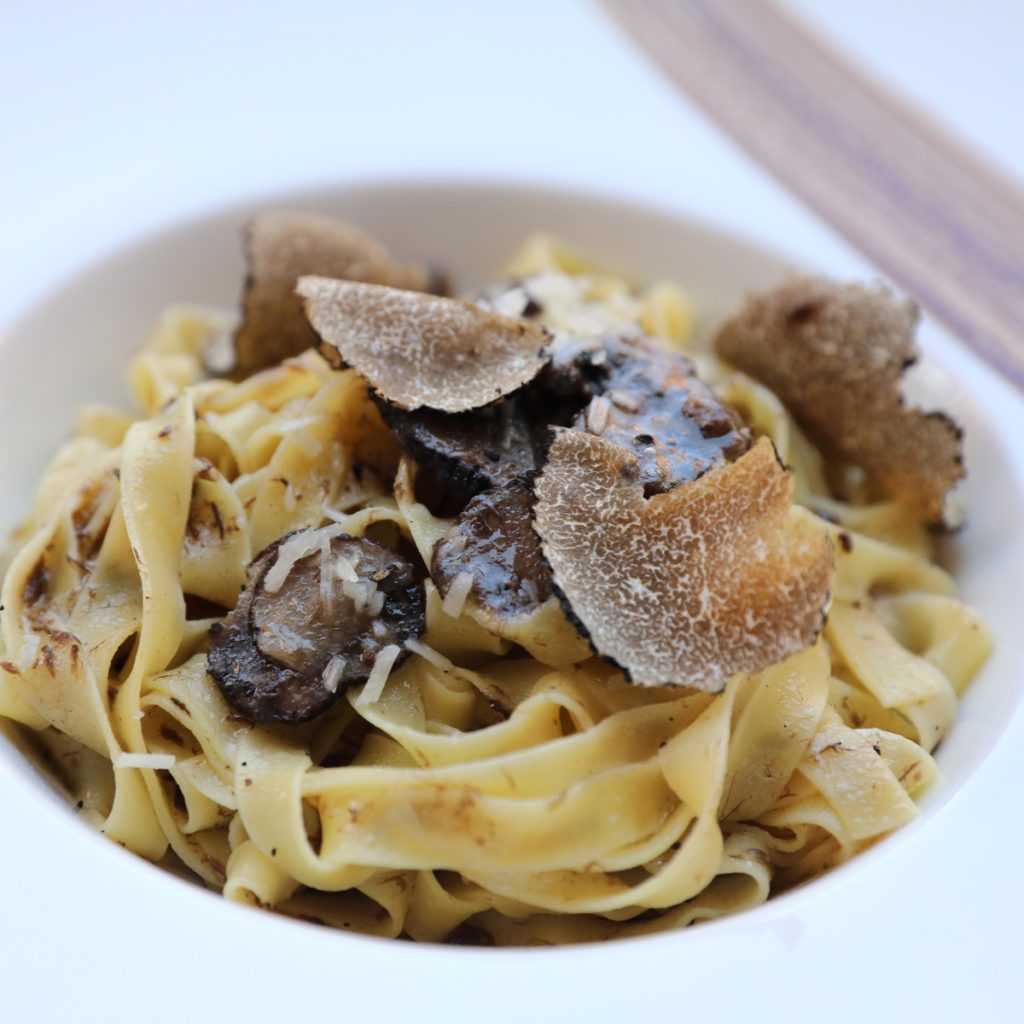


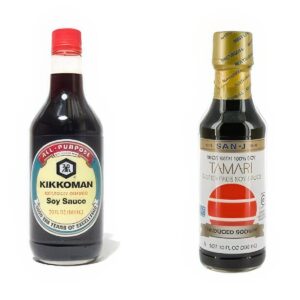
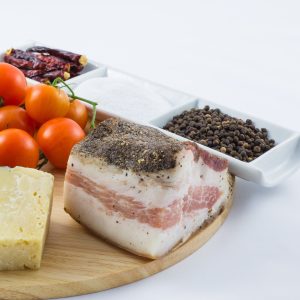
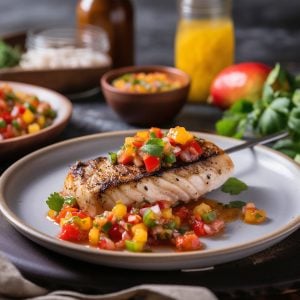
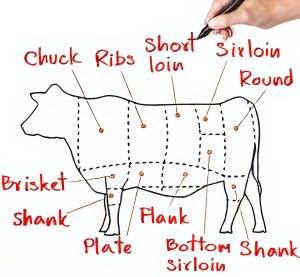
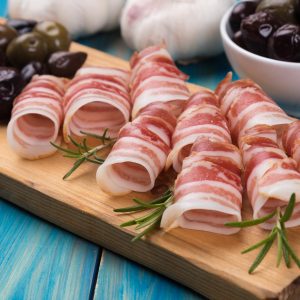
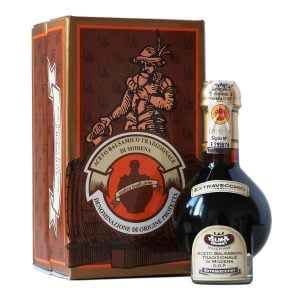
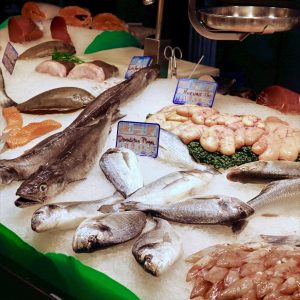
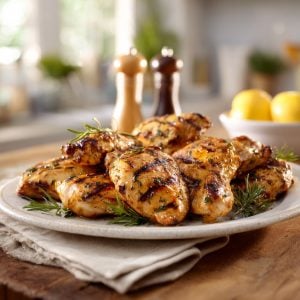


2 Responses
Thanks for sharing. I happened to watch a programme on tv which briefly featured a dog hunting for truffles and it was nothing like the truffles I knew.
This article written by The Reluctant Chef is very informative. Thank you for posting.
After making my own healthful version I wondered who brought the piggy found truffle from the forest floor to the desert table. My own interpretation was either humble country folk , a creative granny or a French chef. L’Esscofier apprentice ,truffle hunters world wide thank you for you wonderful mistake! I imagined the creation to be purposeful to mimic the long sought for forest floor “mushroom” and bring its lumpy form to the desert table as the delicious chocolate creation to the amazement of dinner guests. Yes, I have learned truffles are fungi and the Latin name is less appealing in English.
Are Belgian truffles best? What is your pick? Now I know why there are white and dark chocolate truffles in the chocolate box. Thank you again Monsieur Le Reluctant Chef.
Must check my truffles to see if they are lumpy oh yes,I mean delicious. Prefer Belgian truffles any day!